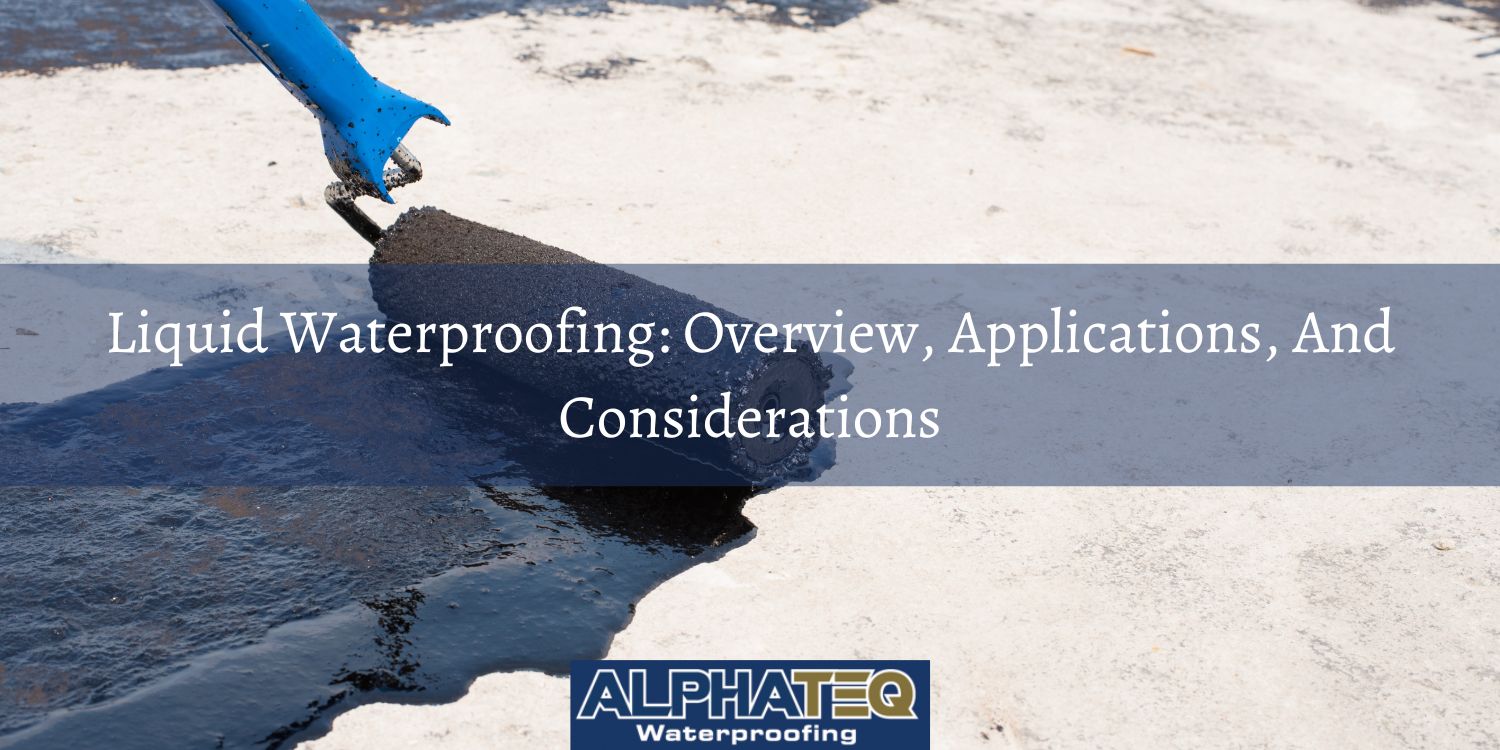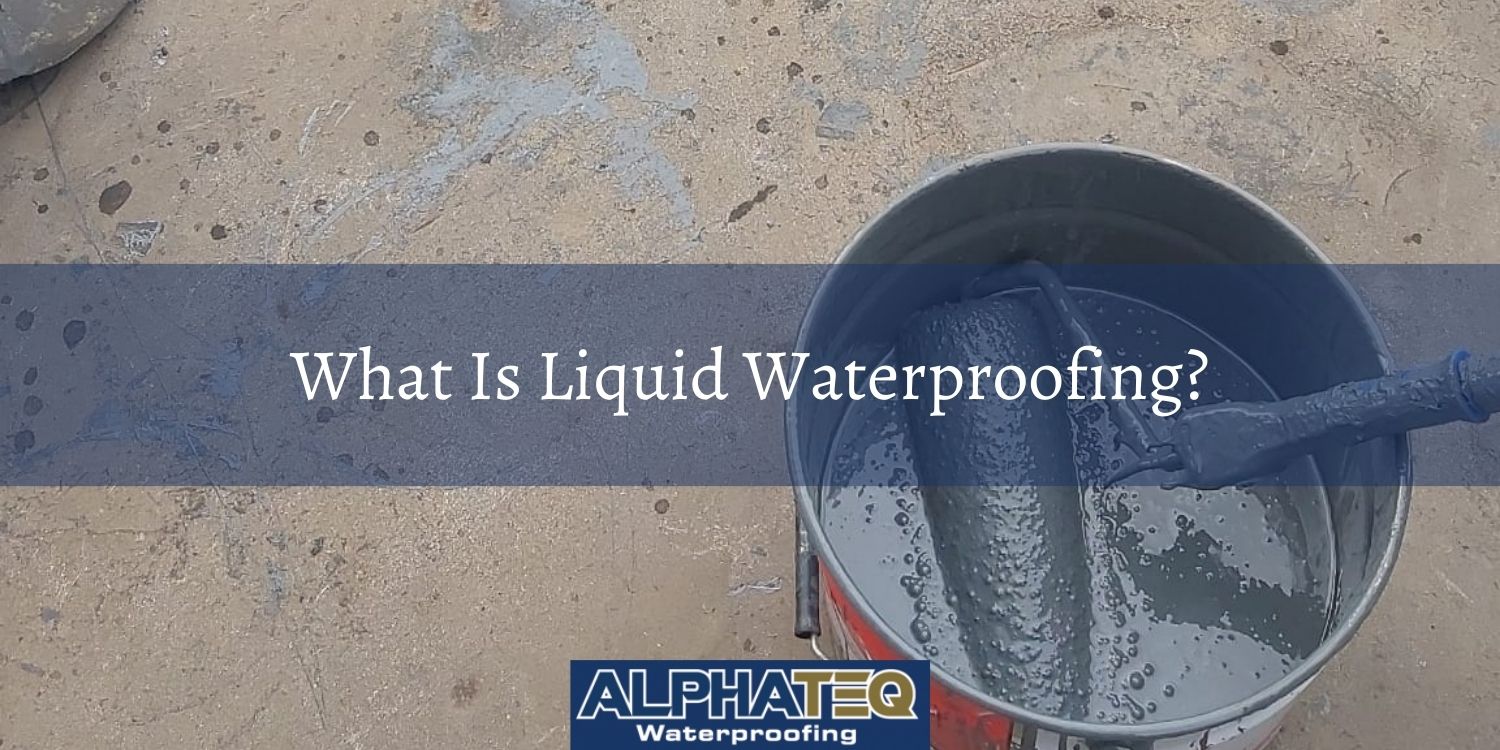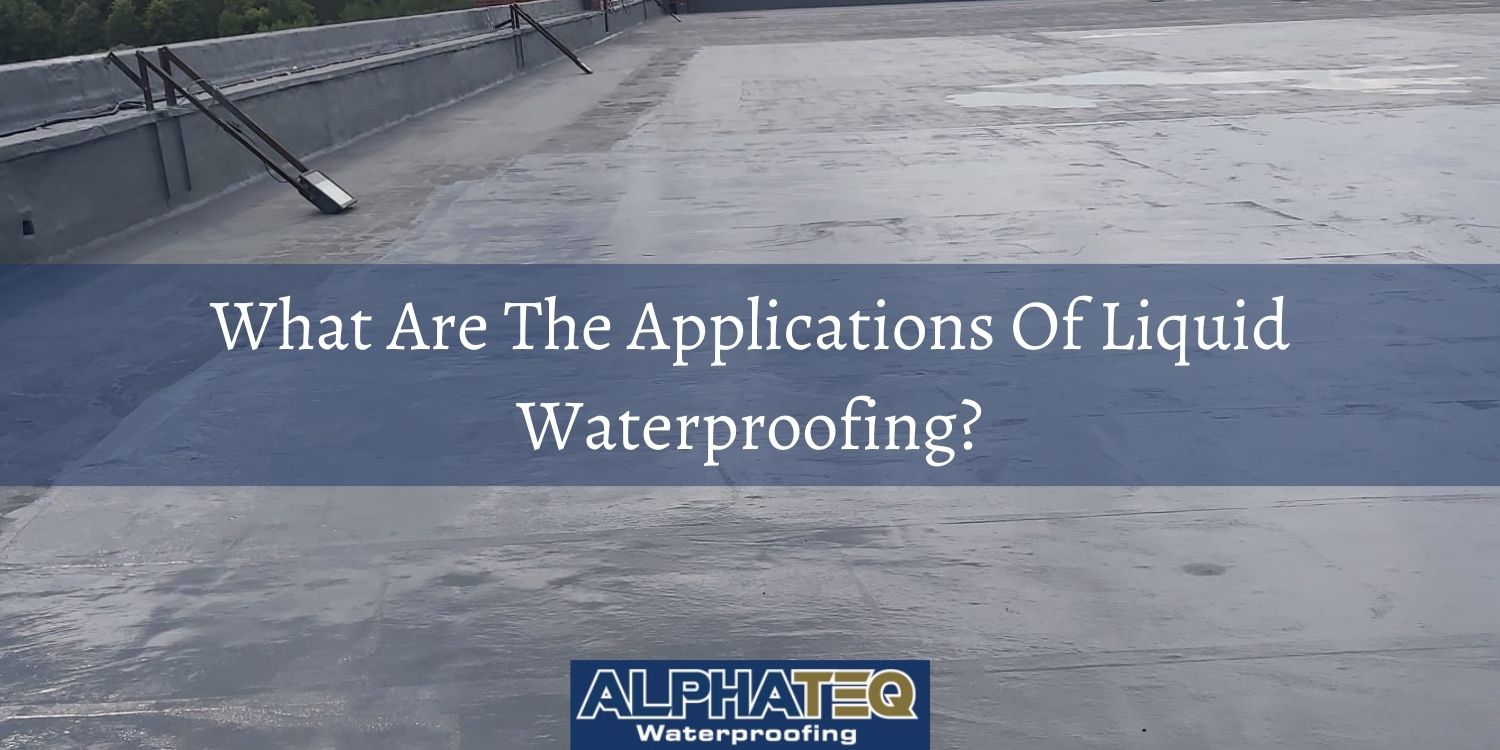I agree Our site saves small pieces of text information (cookies) on your device in order to deliver better content and for statistical purposes. You can disable the usage of cookies by changing the settings of your browser. By browsing our website without changing the browser settings you grant us permission to store that information on your device.

Liquid waterproofing is a technology which involves applying liquid to a surface to prevent water intrusion. The liquid used to provide this waterproofing layer can vary between products. This has given rise to a number of different liquid waterproofing systems. The composition of the liquid used in the systems results in varying strengths and weaknesses. Systems using the same material can also vary greatly between different brands. Here we will provide a detailed understanding of liquid waterproofing, the types, the different applications, the benefits of using a liquid applied system, limitations, how liquid compares with other waterproofing methods and much more.

Liquid waterproofing is a robust system which uses monomeric or polymeric liquid on surfaces to prevent water damage. On drying, this liquid turns into a polymer. The result is a seamless, flexible membrane. This membrane forms an impermeable layer, resisting water effectively. It's a versatile form of waterproofing which is used across a range of industries. The durability of liquid stands up well against environmental stresses. The membrane's strong adhesion and flexibility accommodate surface movements and minor cracks. Further attributes include, cold applied liquid systems being available and having the ability to form to any shape making it perfect for complex details.
The science behind liquid waterproofing is a process called polymerisation. During polymerisation, the liquid waterproofing substance's monomers react to form a polymer. This results in the formation of a tough, durable membrane which is UV stable. The membrane has an inherent elasticity which allows it to encapsulate the substrate whilst coping with thermal movement. This protects the substrate beneath from water and UV rays.
A liquid applied system is a versatile solution known for its flexibility, seamless application, and compatibility with a number of substrates. When applied correctly it effectively protects surfaces against harsh weather conditions, UV radiation, and water damage. Liquid membranes require less maintenance and offers a longer life expectancy (25 years) than other forms of waterproofing.
The different types of liquid waterproofing materials used include; bituminous and cementitious liquid waterproofing through to more advanced options like polyurethane, acrylic, and silicone liquid waterproofing. Each has their own unique characteristics which make them ideal for specific applications. Below we will look at these materials, detailing their composition, properties, and their ideal use cases.
As you can see, liquid waterproofing is broken down into a number of different materials. With each material providing benefits for different applications. Below we will look at the variety of applications in which liquid waterproofing can provide solution.

Liquid waterproofing has a wide array of applications, from roofing systems through to foundations, bathrooms and balconies. This is largely due to liquid membranes having the ability to provide a durable impenetrable barrier which can perform on various substrates including those with extremely complex detailing. Here we will look at these applications in more detail, discussing the benefits and considerations for using liquid waterproofing in each case.
Liquid roofing systems are now widely used, especially for flat roofs. What makes liquid roofing so attractive is it is equally suitable for the waterproofing of a new or existing roof as well as for roof repair. The initial success of liquid roofing was propelled by the ease of application, a seamless finish and the reduction of contractor risk. However, as technology has advanced further benefits have emerged. This includes products which are; cold applied, fast curing, solvent free, highly elastic and fully reinforced with fibres.
Liquid waterproofing offers an effective barrier against ground moisture, for this reason it is often used for basement and foundation waterproofing. Its application helps prevent water ingress, preserving the structural integrity of the building.
Liquid waterproofing is ideal for wet rooms and bathrooms due to having an excellent ability to resist continuous water exposure. It is an easy to apply waterproofing membrane which effectively guards against potential water damage, providing a long-lasting solution.
Balconies, decks, and terraces require waterproofing solutions which can withstand weather changes and constant exposure to the elements. The high elasticity of many liquid applied membranes makes this type of waterproofing especially suited to the task. Not only can such systems stand up to thermal movement they are often cold applied liquid waterproofing systems. This provides an added benefit of minimal disruption to adjacent areas whilst waterproofing is taking place. High elasticity, a cold applied application and the ability to provide an appropriate top coats finish are the key factors on deciding on the correct liquid applied membrane for balconies, decks and terraces.
Waterproofing with a liquid applied membrane is a meticulous process which involves several steps. We will look at this process in detail, starting with surface preparation through to the curing and finishing process. At each step we will provide an explanation of why the step is required and explain how it contributes to ensuring an effective waterproofing barrier once the process is completed.
Surface preparation is the foundation of any waterproofing. Before applying a liquid applied membrane, the surface must be clean, dry, and free from any loose particles. This is process is normally completed by using power washing. Any existing cracks or joints should be sealed. In most cases a pu sealant will be the best way to seal any cracks or joints in the substrate.
The application of a primer is to ensure excellent adhesion. Without a strong bond between the waterproofing membrane and the substrate the effectiveness of any waterproofing system will be adversely affected. It is highly recommended to consult with the manufacture of your waterproofing product as to what primer will give results. It is also advised to conduct a peel test. Primers help enhance the longevity and performance of the waterproofing system.
Once a primer is applied, the liquid coating can be applied. In nearly every case modern liquid systems require no hot works and are completely cold applied. The application is normally with a brush, roller or specialist spray. The use of spay applied liquid can drastically increase the speed of installation when used on large areas. Typically a liquid system involves 2 coats. There are 2 ways in which such a system may be applied. If it is a wet on wet system, the top coat (2nd coat) will be applied one the base coat (1st coat) has soaked through the reinforcement membrane (polyester fleece or GFM matting). For other 2 coats systems the process is slower. The base coat is applied then once it has cured, which is typically a period of 24 hours, the top coat can be applied.
After application, the membrane is allowed to cure. Curing time can vary depending on the product and weather conditions. Some systems are fast curing and are able to tolerate rainfall in as little as 4 hours. Once the liquid applied membrane has been applied additional coats with special properties can be applied if necessary. Such finishes include anti-slip and extra hardness to withstand heavy traffic.
A liquid system offers a host of advantages over traditional methods. Notably, the ability to; provide a seamless application even with complex detailing, perform in a variety of applications and excellent durability, compatibility with a wide range of surfaces, and the relative ease of application. All of this makes liquid waterproofing solutions highly efficient and cost-effective. Below we will analyse these advantages in more detail.
Liquid applied systems provide a seamless, joint-free membrane which fully adheres to the substrate. This eliminates potential weak spots, providing superior waterproofing protection.
Liquid products offer excellent flexibility. Due to being a liquid they can easily accommodate surface movements and minor cracks. This combined with being highly durable with the ability, withstanding weathering and UV radiation make them ideal for a variety of applications. This includes; refurbishment projects such as flat roof repair through to car park decks, green roofs and balcony waterproofing.
The flexibility and durability of liquid products is compounded as they can be applied to waterproof most substrates. This includes concrete, metal, wood, and more. However, it is important to check which primer is required with the manufacturer and to conduct a peel test.
While professional installation is advised for optimal results, liquid applied systems can be easier to apply than some other waterproofing methods. This means the skill requirements are not so high meaning your choice of contractor dos not carry as much risk. However, it is always recommended to seek an approved contractor and if you have any doubts check with the liquid manufacturer for advice. Systems which are cold liquid meaning they do not require heat for installation, also provided the benefit of a vastly reduced fire risk. With regards to choice of liquid product it is always recommended to select one which is BBA certified.
Despite its numerous advantages, liquid waterproofing does present certain challenges. These can range from the need for professional application and weather constraints during application, to the requirement for regular maintenance and potential cost considerations. Below we will look at these challenges in more detail.
While the application of liquid waterproofing can seem straightforward, professional installation is often advised. This is because an incorrect application can lead to failures in the waterproofing system. Although contractor risk is lower when choosing a liquid system, a certain level of skills is required. The best way to ensure a correctly installed liquid membrane is an approved professional contractor.
Weather conditions can cause issues with the application of liquid waterproofing. Cold or wet conditions can interfere with the curing process, which can compromise the membrane's effectiveness. The best way to navigate this is to build space in your installation schedule for adverse weather causing delays. And to choose a rapid curing liquid which protects the substrate from rain within 4 hours of application.
Despite its durability regular inspections and maintenance are necessary. Sticking to a regular maintenance schedule can lead to liquid systems performing beyond their expected service life. Any damages or wear should be repaired promptly to maximise the system's effectiveness.
The cost of liquid waterproofing can be higher than traditional waterproofing methods. This is especially true for high-quality products which use quality materials and are BBA certified. However, the long-term benefits of better performance resulting in less maintenance being required can easily offset the initial cost.
To fully appreciate the benefits and limitations of liquid applied waterproofing, it's helpful to compare it to other waterproofing methods . These methods include; sheet-based, cementitious, and integral. Below we will look at how liquid waterproofing systems compare to these alternatives.
Sheet-based systems involve the application of sheets to form a waterproofing membrane. Such systems include single ply. A weakness of this system is it has seams. These are areas which have significant potential to be penetrated for water ingress of the lifespan of the system. Choosing a liquid over a sheet based system for green roofs is one such case. Having a liquid applied membrane waterproofing a green roof system eliminates the worry of having seams and the potentially disruptive repair work. This is why liquid is increasingly specified as a part of green roof design. Liquid applied systems do not have this problem as they create a seamless, fully adhered membrane. This point is accentuated as liquid is often the ideal solution for an overlay on sheet based waterproofing systems like single ply and modified bitumen which have failed. This method is most often used to make an existing roof waterproof again after failing.
Cementitious systems are often used for internal areas like toilets and bathrooms. The advantage of such systems are they are easy to apply and provide great durability. However, one weakness is the lack of flexibility. If the area to be waterproofed can be sure not to have to cope with thermal movement cementitious waterproofing is a great choice. However, if there is the potential for any thermal movement a liquid membrane is the superior choice.
Integral systems are where a waterproofing compound is added to a concrete mix. The result is the concrete itself is waterproof. This is an effective system. However, it does have one major weakness; cracks developing in the concrete due to substrate movement. This is where liquid is superior due to it have excellent elasticity allowing it to cope well with thermal movement.
The field of waterproofing is always evolving. New innovations and technological advancements pave the way for more effective and efficient solutions. Here we will look at the use of advanced polymers, nanotechnology and how an increased focus on sustainability is shaping the future direction of this industry.
The use of polymers in waterproofing is constantly evolving. New combinations of materials with polymers as well as advanced technology is experimented with in order to provide enhanced waterproofing solutions. These advancements normally centre around improved durability, elasticity, and resistance to environmental stressors.
Nanotechnology is being used to provide waterproofing materials with superior properties. Nanoparticles can be used to enhance the ability of liquid membrane's ability to resist water penetration, UV radiation and other forms of damage.
There's a growing demand for sustainable and eco-friendly waterproofing solutions. This is due to an increased awareness of construction materials and their impact on the environemnt both in the short and long term. The main areas where manufacturers are attempting to improve waterproofing products to cater to this demand is the reduced use volatile organic compounds (VOCs) and using renewable resources for liquid applied products.
When applied correctly, liquid systems can offer long-lasting protection against water ingress. However, ensuring optimal performance requires adherence to certain best practices. Here we will look at these best practices in more detail. These practices include; the importance of professional assessment before installation, then the use of quality contractors for the installation, tips on maintaining a liquid system, the necessity of regular inspections.
It is important to get professional evaluation before the installation of any liquid waterproofing. Using a profession to help identify the most suitable liquid waterproofing product for a specific application can make a huge difference in the longevity of a waterproofing system. For example, existing roofs which are beginning to fail are often able to be saved and have their lifespan extended for 10 years or more if the correct product is choosing. It goes without saying using a quality contractor for installation will maximise your roofs life expectancy and ensure the finished roof has an aesthetic finish which is also functional.
In order to maximise the lifespan of your waterproofing membrane, regular inspections are essential. These should be scheduled in on at least a yearly basis. For a commercial liquid waterproofing system every 6 months is recommended. The inspection is the cornerstone of a roof getting the longest lifespan possible. The inspection allows for the detection of potential problems before they develop and the timely intervention on areas which need repair. Off of this inspection you are able to carry out repair work to the waterproofing system in order to ensure no larger more expensive problems develop.
If you would like further information about the liquid systems we can provide please get in touch with us through our contact form or call us on 01277 503 110. One of our team of waterproofing experts will be happy to help.